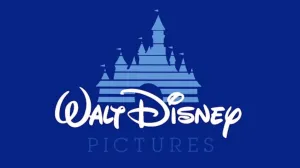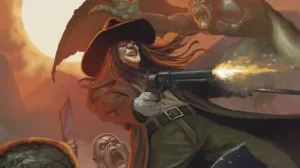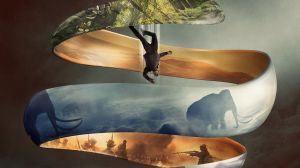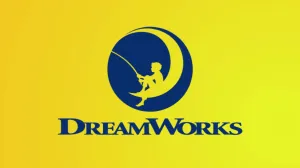Phil Jimenez is one of the most beloved artists in the comics industry, and has been for years, with acclaimed runs on books like Wonder Woman and The Invisibles as well as event cred with projects like Infinite Crisis.
Videos by ComicBook.com
So it was probably a little surprising when, after the release of just one issue, a fair number of people on social media were cursing his name.
Of course, that one issue was the launch of DC’s Superwoman, in which the lead character who had been advertised — the New 52 version of Lois Lane, now with a fraction of the late New 52 Superman’s powers — seemed to die and turn into sand, just as her Superman had.
So…yeah. While most readers loved the way Lana Lang was handled and not only the fact that she had powers, but especially the form and appearance those powers took on was a surprise, there was a not-insignificant portion of the fandom who were shocked and saddened to see that the heroine they expected to be following for the life of the series had lasted just under 20 pages.
Jimenez joined ComicBook.com to discuss the series, the second issue of which comes out on Wednesday. You can get a copy at your local comic shop or pre-order it digitally on ComiXology.

I’m going to start off with a random crafty question because this is something that I’ve wondered for about 20 years: Do you use models or photo reference when you’re drawing?
I actually always try to have some sort of photo reference. I know you can really see it when I’m using it and when I’m not. It all depends on pace and production. But if I can have a photo reference, particularly for things like vehicles and buildings, but certainly people and certain poses I try. I teach at the school of visual arts and it’s a big, big topic of conversation. Reference and how to use it.
As I get older too I try even more. For example, Superwoman, I actually have a friend who models for her, Natasha. I have a friend who’s modeled for her. I’m personally not great at making things look like photographs, but I want them to look recognizable.
Was the idea of the big twist at the end of #1 something that you brought to the table? Or was that part of the concept when Superwoman was out for people to pitch or whatever?
The big twist was mine. Actually, both of the twists in that book were mine. When they brought to me the Super Woman project they assigned to me a cast of characters including supporting characters so it was sort of my job to flush them out and I worked with Geoff Johns to work on some story deets that we needed to hit in the first two issues but the mode of doing that and the way that story was told was essentially mine.
I worked really, really hard with my editors and they were actually … their contribution cannot be undersold. Especially Paul Kaminski, who is actually a former student of mine in the School of Visual Arts. He has been amazing to work with. I’m name dropping. He’s brilliant. I have been able to show so much to him and he gets a lot of what I’m doing. We’ve had some arguments. I don’t think he was fond of a few things I was talked out of but I won and whatever.
Going back to your original question. The twist of Lana being Superwoman to Lois’s apparent demise, those were mine. The demise particularly was, I just pulled the old Game of Thrones playbook. You never know who’s going to survive. I wanted to play a little bit with expectations. I tried very, very hard not to over talk it on the Internet. Because I wanted to surprise with the same and I wanted people to leave the thing cold and just sort of take it without knowing there would be a big twist at the end. It seems to have worked.
The people who were upset were largely not so much upset with your one issue as they were they felt that the new Lois never really found her groove and that this is an extension of this character not getting her due. Is that something that even occurs to you when you’re trying to craft your own story? The long game of this poor character who’s been through the wringer?
A couple things. I understand why people did not love this Lois Lane. Of course it’s so easy to say the story not over yet – but that’s certainly true.
To imagine that I would so casually cast off an important character, no matter the iteration…I don’t want to say stuns me. It’s comics and we’re comics fans. We all get upset about a lot of things. But I think I did that knowing full well what was coming down the pipe. Of course nothing is true until it is in print. Nothing is set in stone until it’s on paper but I’ve known the long term plans for a very long time. I would never ever just do something so casually without thinking about it both historically, short term, long term, politically, from story, etc.
All I can say of course and all I’ve been saying is that the story is not over yet. There’s plenty more. I’m very cognizant of the complaints of Lois Lane fans and particularly fans of New 52 Lois. My hope is that they will check in if they’ve checked out, from time to time over the next couple months, because I think they will be surprised.
I think about that all the time. I think about people’s investments in this work all the time. I never want to be dismissive of that. I never want to disregard that. People spend a lot of time and money and emotion investing in these works and these stories. The last thing I want to do is throw them aside.
Unless I think I have a good reason or unless the company says, “Do this!” which, having worked there for 25 years, that does happen occasionally. I grumble and mutter and do my job. [Laughs]
When you decided to bring her in as the second Superwoman, what made you decide that that was the way to go? That ’96/97 that power set, that look?
Lana was assigned to me as one of the Super-women. The DC side of that was going to be an uncertain character from the book. In The New 52, Lana is an engineer. Lana also happened to teach Superman how to use his powers.
One of the things I wanted to do was obviously pay homage to a different time period and to readers who remembered those works and remember them fondly. It was too easy with a red-headed character and Lois to not do red and blue. It just seemed so obvious.
More than anything, I didn’t want another super-strong “Super”-person. I thought that that ground had been covered and I wanted to make use of Lana’s skills as an engineer and what I imagined a lifetime of thinking about Clark’s powers and say, “Hey, what if I just did this?” And suggested that she convert solar radiation in a very different way than he does.
I’ve been consulting with some scientists and that’s been very exciting. You’ll see it definitely in issue three, but will continue is that she is figuring out all sort of ways to convert solar radiation into other kinds of radiation. Not only does she have some super strength and the traditional super hearing, etc. but now she can project electricity.
There’s the Atomic Skull, [against whom] she finds out what she can do. I wanted to give the super universe a Superwoman who is not just a female version of Superman. It was a way to play up to Lana Lang’s character strengths as an engineer and to bring some science into the book.
As spoiler-free as we can be here — there’s another big last page reveal, and I think most people who have been following along in the last year of DC Comics are going to wonder, “What the hell? How did that happen?”
It’s a good question. Issue #3, actually will explain how that happened. As for what’s going on, there are answers believe it or not! I would say read #3.








